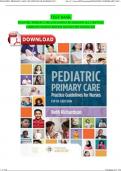Exam (elaborations)
TEST BANK PEDIATRIC PRIMARY CARE 5TH EDITION RICHARDSON ALL CHAPTERS COMPLETE ISBN: 9781284248302 NEWEST EDITION 2024 INSTANT DOWNLOAD PDF
TEST BANK PEDIATRIC PRIMARY CARE 5TH EDITION RICHARDSON ALL CHAPTERS COMPLETE ISBN: 9781284248302 NEWEST EDITION 2024 INSTANT DOWNLOAD PDF Test Bank For PEDIATRIC PRIMARY CARE 5TH EDITION RICHARDSON ALL CHAPTERS, VERIFIED CHAPTERS Pdf Chapters Download Test Bank For PEDIATRIC PRIMARY CARE 5TH EDITI...
[Show more]



